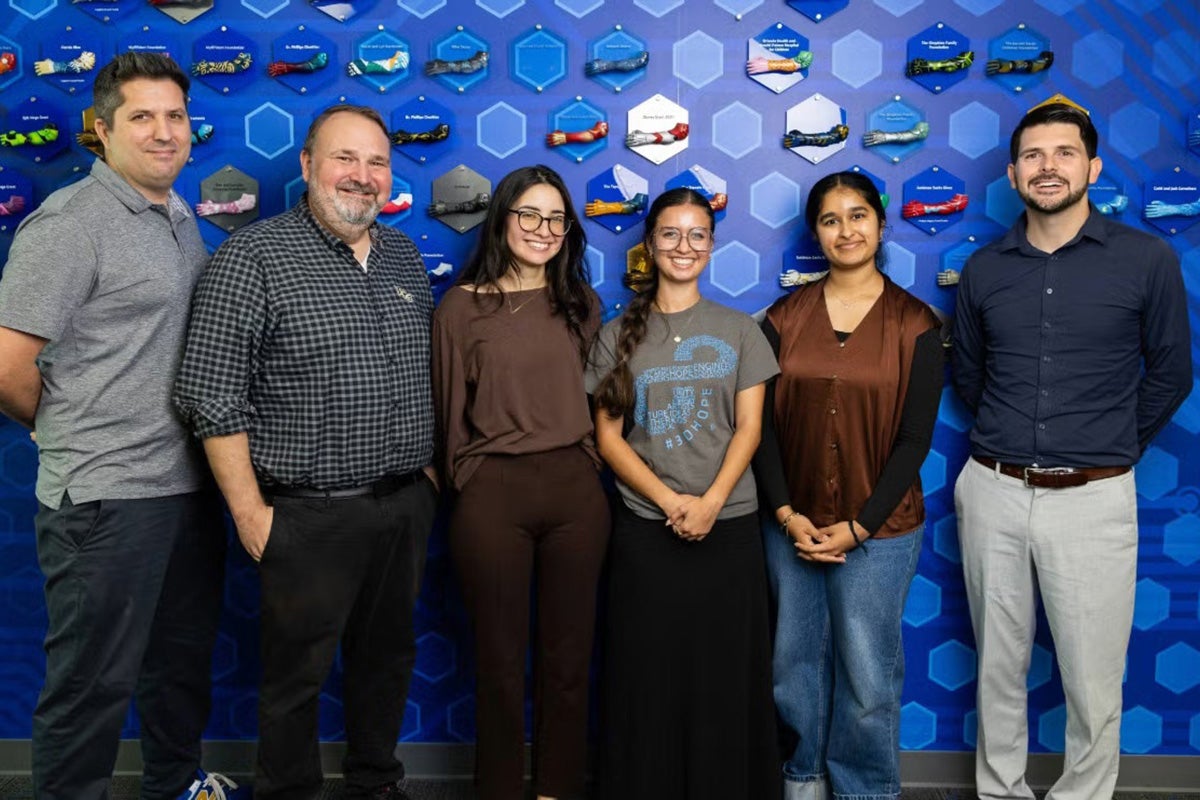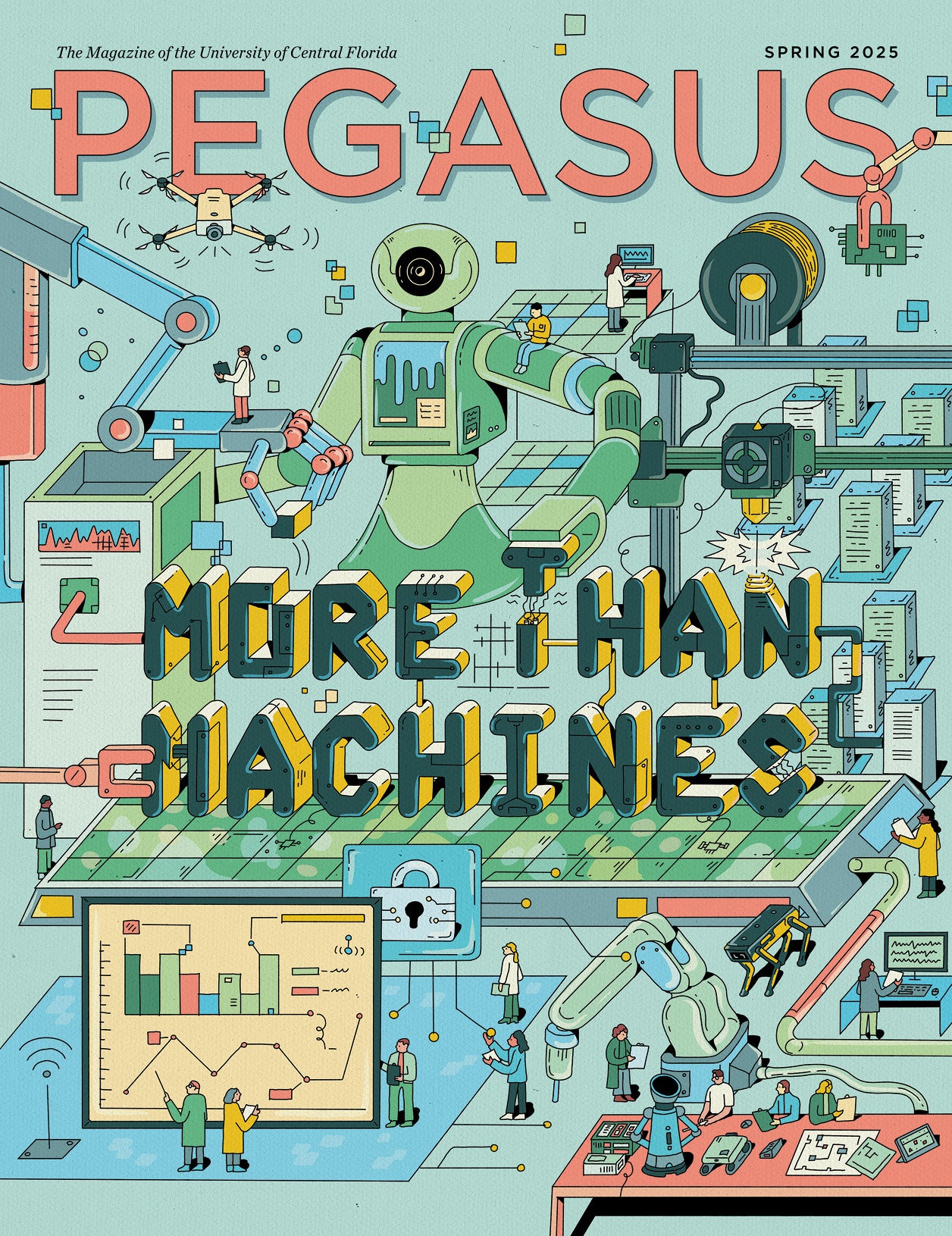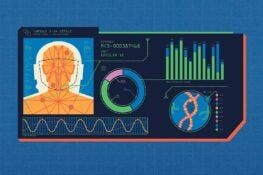Limbitless Solutions continues to reach the next level in connecting people with accessible medical technologies through its gamified training research.
The UCF-based nonprofit celebrated 10 years of developing and creating pediatric prostheses in 2024 and is also renowned for its complementary advancements in gamified training that empower patients to master their accessible medical technologies.
Limbitless researchers recently published two new studies aimed at improving training games. One, published in Simulation & Gaming, explores how machine learning may streamline level design for bionic arm training games. The other, a playtest study published in Applied Sciences, evaluates the efficacy of a new training game to assist patients with severely limited mobility who use an eye-tracking wheelchair.
Together these two studies exemplify Limbitless’ continued commitment to ensuring patients feel connected to the new technologies they receive, gain confidence in overcoming their conditions and ultimately transform their lives.
“These games are now fully integrated into the Limbitless experience,” says Peter Smith ’05MS ’12PhD, Limbitless’ head of game development and training, associate professor and director of the games and interactive media program within the Nicholson School of Communication and Media. “The kids get the games first to learn to use and strengthen muscles they may not have needed to use before. The goal is to have the kids practice and learn in the games, and have all their failures in the games so that when they get their arms, they are immediately successful.”
The researchers at Limbitless aim to give patients comprehensive care. It isn’t enough to provide a bionic arm, nor is it enough to make a game that’s just fun but lacking in training, says Limbitless Creative Director Matt Dombrowski ’05 ’08MFA.
“Limbitless is more than technology, games or picking things up — it’s about giving children with limb differences agency,” says Dombrowski, who’s also a professor at UCF’s School of Visual Arts and Design (SVAD). “The training games are designed to be the first step on that journey to build trust, excitement and self-belief through play. Embedding this development inside SVAD and Nicholson, with guidance from Peter and I, we ensure the work stays grounded in both creative innovation and research-backed methodology.”
“The training games are designed to be the first step on that journey to build trust, excitement and self-belief through play.” — UCF Professor and Limbitless Creative Director Matt Dombrowski ’05 ’08MFA.
The idea of using immersive gamified training was conceived early on, says Albert Manero ’12 ’14MS ’16PhD, executive director and co-founder of Limbitless Solutions.
“One of our colleagues here at Limbitless reached out to some of the faculty at SVAD and asked them if they could help create some of the cosmetic components of the prosthetic limbs,” Manero says. “One of those faculty members countered with, ‘Have you ever considered making video games around these arms?’ Ever since then, it’s just kind of snowballed into what we have here today, which is being able to improve the quality of the training and the onboarding for our patients, whether those are with the bionic arms or the face gesture-controlled wheelchair.”
The Journey Forward
Limbitless’ Project Xavier is a specialized wheelchair that uses the same electromyographic (EMG) technology used in the bionic arms to power an electric wheelchair completely hands-free. It works by using a sensor placed on a person’s temple to detect subtle facial movements and translate them into directional control.
The wheelchair is designed to help people with limited mobility, such as those with amyotrophic lateral sclerosis (ALS), regain autonomy and use some of the muscles that are the last to lose function as the condition progresses.
Their recently published research explores how a training game called Limbitless Journey can help determine muscle strength, assess user comfort with using the wheelchair and examine the potential for integrating eye-tracking technology.
“We want to make that experience the lowest stress possible and the most beneficial as possible for wheelchair users,” Manero says. “This research paper really looks at that usability evaluation and helping be able to understand how humans interact with machines and simulations … to better improve dexterity and mobility control.”
Manero says he saw a need for a specialized wheelchair that can adapt to its users as their body changes over time. Recognizing that this technology may seem complex and potentially intimidating, Limbitless was inspired to go one step further and develop a training game to accompany Project Xavier.
“The wheelchair project came about from a friend who was using a powered wheelchair. We really learned [that] for [people with] neuromuscular disorders, there can come a point when their hand is just not sufficient to be able to control their wheelchair,” Manero says. “As we learned more and more about the experience for those patients, we realized that there is a real need for hands-free wheelchair technology.”
Evaluating how people use the training game to learn how to use their wheelchair was the key takeaway from the study. Participants in the study praised the level of design and provided suggestions, stating that eye-tracking technology could be improved. The researchers also concluded that objective-based minigames within the game may be implemented.
With this feedback, the Limbitless team members say they are hopeful that the training can reach its full potential.
“This research paper really looks at that usability evaluation and helping be able to understand how humans interact with machines and simulations … to better improve dexterity and mobility control.” — Albert Manero ’12 ’14MS ’16PhD, executive director and co-founder of Limbitless Solutions.
“We started working with a clinical trial with the Mayo Clinic in Jacksonville. In that trial we found that people were nervous to learn how to use the chair,” Smith says. “So we started building this game that would allow them to practice before getting put into that experience.”
The game’s eye-tracking technology works by using an infrared camera across from the user to detect eye movement and translate it to the user interface. The user can “select” an option by maintaining eye contact with a specific point on the screen for a duration of time.
Receiving steady gameplay input from testers is crucial to designing a training game that is both intuitive and enjoyable, Smith says.
“I think that the key for any kind of training game is to make sure that you’re focusing on the learning objective or the training outcome that you want,” he says.
Navigating through feedback and customizing the experience for all levels of users is something that Dombrowski says he bears in mind when developing training games.
“It’s really about understanding [that] our audience is ever-changing and each person is going to be completely different,” he says. “Our big goal is to make this scalable, to have experiences that are peaceful, slow and calm, and then also have experiences that maybe ramp that up a little bit more.”
The team is encouraged by the valuable input the testers provided and are excited to keep the project rolling, Dombrowski says.
Training Together with Machine Learning Agent PAUL
Limbitless has been using gamified training to help pediatric patients feel empowered when receiving and using their arms.
Their latest research on training games takes their concept further and explores the efficacy of machine learning to reduce user frustrations and streamline game development.
“The study helped us build on the testing and validation of the level design, which supports improving the testing,” Manero says. “It also helps our team to accelerate the design phase so that we can have the games in use by our bionic kids. Building on the use of machine learning will enable us to make training games that support faster and more robust learning, while we work to have them be as much fun as possible for bionic kids.”
For this work, a machine learning agent dubbed “PAUL” (Program for Autonomous Unity Learning) was integrated into an endless runner game called Limbitless Runner, which contains obstacles and power-ups that the user must avoid or collect. Past work with Limbitless Runner proved effective in training muscles with an EMG game controller to prepare users for bionic arms.
The researchers concluded PAUL can determine the feasibility of gameplay. The machine learning agent allowed the team to refine the design process, provided an artificial intelligence (AI) player to race against in the game, and offered comparisons in optimizing and evaluating user progress.
The researchers say they envision future work focusing on using machine learning to reduce potential frustrations by recognizing imperfect reactions and much more.
“We envision a future where all these types of AI can exist in our training games and support the bionic kids in using their prosthetics,” Smith says. “Going forward, we will likely use more machine learning agents for verification and possibly for non-player characters, but we are also interested in other AI applications.”
Dombrowski says he believes machine learning can expand access and even customize the experience for patients.
“This holds exciting potential for helping us fine-tune training protocols,” he says. “We can identify patterns and make data-informed adjustments to how difficulty is scaled or how muscle control challenges are presented. Eventually, [AI] could even support automatic personalization for each child based on their learning capability and progress, ensuring that training meets them where they are.”
Gamified training also provides an exceptional opportunity to study how children may interact with their bionic arms in ways that are distinct from a lab setting. This gives researchers a fuller perspective, Dombrowski says.
“Games provide immediate feedback, narrative immersion, and, perhaps most importantly, a space where failure is expected and retrying is encouraged,” he says. “This mindset shift is critical because if a prosthesis doesn’t work perfectly right away, it can negatively affect a child’s willingness to continue using it.”
“We envision a future where all these types of AI can exist in our training games and support the bionic kids in using their prosthetics.” — Peter Smith ’05MS ’12PhD, Limbitless’ head of game development and training.
By blending machine learning with nearly a decade of existing gamified training knowledge, the goal of training games like Limbitless Runner is to take a proactive approach by helping patients build confidence, Dombrowski says.
“Helping children hone their muscle control in game environments gives them the foundation to succeed once they transition to the real prosthetic,” he says. “Over time, they progress from simply making a basic flex to using different levels of muscle engagement to trigger multiple gestures and controls, creating an intuitive pathway from gameplay to real-world usage.”
Gamified training is deeply integrated into the Limbitless experience — from researcher to patient — so the opportunity to continue building on proven concepts is exciting, Manero says.
“We are still working to prove the improvements from the training, but we have seen the impact anecdotally,” he says. “The gamified training is a key component of our clinical trials, with each arm being accompanied by a training video game system. Our study revealed some unintended responses to design decisions and gave our team a great opportunity to strengthen our design and testing.”
A Full Body of Work: Where Art Meets Engineering
Interdisciplinary collaboration is a hallmark of UCF’s research enterprise. The convergence of art, engineering and game design is a critical component of Limbitless’ success, and it helps give students engaged in the nonprofit’s research a fuller experience, Manero says.
“I think one of the most exciting parts about Limbitless is seeing how our student researchers can go from video games to engineering to the clinical sciences, and translate that to our patient group,” he says. “It’s a special environment to watch artists, game designers, engineers, and premedical students all sit together and work on a project. And that seems to be unique to UCF and Limbitless Solutions.”
Seniors Delaney Gunnell and Maanya Pradeep, who are both majoring in biotechnology and biomedical sciences, respectively, say that their experience working on the eye-tracking wheelchair paper has enriched their exposure to undergraduate research and accelerated their exposure to collaboration across disciplines.
“This has been a great learning process,” Gunnell says. “I gained a ton of experience, and now I’m able to use the skills we learned together for coding and analysis to help other scholars here with their projects.”
Being immersed in the research and interfacing with colleagues allowed Gunnell and Pradeep to quickly develop a leadership role amongst their peers and prepare for careers after graduation.
“I think something that’s really valuable for me was the manuscript writing and the technical skills associated with that,” Pradeep says. “We’ve been helping other scholars here get into writing their own manuscripts, and that’s been a key takeaway. I’m also applying for medical school right now, and so conducting research at Limbitless [has] helped open my eyes to how accessible technology should be designed. As a future physician, it gives me an idea of the patient care aspect of the research process.”
Almost nine years ago, Smith and Dombrowski joined Limbitless and began guiding the next generation of creators by giving them practical education in developing training games.
“It’s a unique academic pipeline that turns classroom learning into real-world, impactful experiences that advance the research and give students tangible outcomes and a deep sense of purpose,” he says. “Cross collaboration and ensuring that everyone plays a vital role is really what UCF is all about, and the positive of it all is [that] we’re helping people.”
Limbitless Co-founder and Director of Research and Development John Sparkman ’13 ’15MS, along with Program Support Specialist Viviana Rivera ’23 ’24MS also contributed to both research projects. Pradeep and undergraduate student researcher Eric Gass ’24 contributed to the prosthesis research.
Limbitless Solutions’ gamified training research is supported by funding through their Unity for Humanity initiative, the Epic Games MegaGrant program and the Pabst Steinmetz Foundation.
Researchers’ Credentials:
Dombrowski is a professor in UCF’s School of Visual Arts and Design, where he combines creative leadership with a commitment to innovation and social impact. As the creative director of Limbitless Solutions, he leads interdisciplinary teams that develop expressive 3D-printed bionic arms, immersive training video games and inclusive digital experiences for children with limb differences. Dombrowski’s work blends digital art, immersive technology and accessibility-driven design. His projects have been featured by Adobe, Unity, Epic Games, Autodesk, the Smithsonian American Art Museum, Game Developers Conference, SXSW EDU and the Gates Foundation. He has helped secure major support through initiatives like Unity for Humanity, the Epic MegaGrant, and national clinical partnerships. A nationally recognized educator, Dombrowski has received numerous teaching honors from UCF, including the University Excellence in Undergraduate Teaching award and the Chuck D. Dziuban Award for Online Teaching. He is a four-time recipient of the CAH Excellence in Undergraduate Teaching award and was named an Adobe Creative Campus Innovator and Adobe Education Leader. Through his teaching, research and creative practice, Dombrowski inspires students to harness visual storytelling and design thinking to drive positive change, expanding what’s possible when the arts intersect with science, healthcare and technology.
Manero is the executive director and co-founder of Limbitless Solutions. He received his doctoral degree in mechanical engineering and his master’s and bachelor’s degrees in aerospace engineering from UCF.
Manero also holds courtesy research appointments in UCF’s mechanical and aerospace engineering department within the College of Engineering and Computer Science, graduate faculty scholar appointments from the College of Graduate Studies and the College of Engineering and Computer Science, and a research appointment in Mayo Clinic’s neurology department. He’s also a member of UCF’s Biionix faculty cluster initiative.
Smith is an associate professor and associate director of UCF’s Digital Media: Games and Interactive Media program. His research focuses on games for health, rehabilitation, education and alternative controllers. Smith has developed and contributed to a wide range of funded and creative games, and he is the lead for game development and training at Limbitless Solutions. His work spans virtual reality post-traumatic stress disorder therapy systems, health and rehabilitation games, educational games and experimental control games. These projects have been exhibited internationally and have received awards such as Alt.Ctrl.GDC Finalist, Most Innovative Game at I/ITSEC. He has served as principal investigator or co-principal investigator on projects funded by sources such as the U.S. State Department, the U.S. National Science Foundation, Unity 3D, Disney, Epic Games and the Pabst Steinmetz Foundation.





